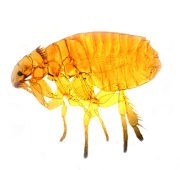Fleas
The vile flea, just like the bed bug, is a blood-sucking vermin. Fleas are small, dark-coloured, wingless parasites which reach up to 4mm in length. They have flat, oval-shaped bodies which allow them to jump over distances over 33 cm long. They have tube-like mouth-parts, suited for feeding on the blood of their hosts.
Let’s take a look at some of the characteristics of those insects:
Most Common Types of Fleas
Feeding Habits
Fleas feed only on bird and mammal blood. Although different types of fleas prefer different hosts, they all bite humans. The main host of choice for the most common species are dogs and cats. Their saliva prevents the immediate detection of the bite. Later it causes severe irritation and itching. Adult fleas locate their hosts by movement, vibrations and animal breath (through warmth and humidity differences in the air, etc.).
Fleas also have larvae that feed on organic and faecal matter. Although they are hatched blind, they can detect adult fleas’ excrements—a sign of a food source nearby.
Health Effects
Although fleas rarely feed exclusively on humans, flea bites can still pose a serious health hazard. Fleas are known to spread a variety of diseases, such as typhus, tularemia, bubonic plague, and cat-scratch disease. Typhus and bubonic plague are notorious for their mortality rates. Still, it is not likely for a human to be infected with them in the UK (due to vaccination and high hygiene standards).
Cat scratch disease is a common and real health threat. It is caused by the Bartonella henselae bacteria and puts people with a weakened immune system at serious risk. It can result in muscle pains, enlarged lymph nodes, reproductive issues and deep inflammations and infections.
Fleas are also known to transmit various kinds of tapeworms, especially between animals.
Where do fleas live?
Depending on the stage of their life cycle, fleas choose to live in different conditions.
Flea Eggs: Dozens of them are laid directly on your pet’s fur every day and fall spread wherever your pet brings them, which means flea eggs can end up in your bedding, furniture, carpeting and even on top of appliances (if you have a cat, you can be sure of it).
Flea Larvae: They like dark, narrow and dusty spaces that offer protection during this immature stage. Flea Pupae are found only on floors and in-between carpet fibre. Despite composing just 10% of a flea population, they are the main reason why flea treatments often fail.
Adult fleas: As adults, fleas hide only on live hosts such as cats, dogs, rodents and any other furry mammal.
Where do fleas live outside?
In your yard and in wildlife, fleas live in high grass, sand, sheds and debris – places where they can find shade and humidity. These areas, such as the grass underneath a shrub, provide the perfect conditions for all three stages of the flea’s life cycle. From the egg lay to the cocoons – and that’s not all. Animals also prefer to go in the shade on hot summer days, and that’s the time for the newly hatched adult fleas to go for a snack!
Where do fleas live on dogs and cats?
The most densely infested areas on your pets’ bodies would be around the neck, ears and underbelly. An even better question is where do fleas come from? A flea infestation can take place even if your pets always stay indoors, as your own vibration and heat can attract a flea while you are enjoying a picnic, fishing trip or just a stroll in the high grass.
Nonetheless, humans cannot actually get fleas – not the common household fleas at least. There’s a species called the human flea, Pulex irritans, that lives on humans, pigs and other mammals that don’t have fur. Those are encountered only in the wild, however, and are different from the fleas found on your cats and dogs.
Check also: How do I know if my dog has fleas?
Causes of infestation
Fleas are transmitted by your pets or by different types of rats and mice. They attach to the fur of the animals from infested dirt or foliage. They usually live in the underbelly area. Once their host goes inside of your home, fleas transfer to your carpet, drapers, furnishings or indoor plants.
Fleas thrive in warm, moist places. Low temperatures halt their developmental cycle. Summer is the season when most infestations occur.
Detection
Look for the following signs of flea infestation:
- Live fleas: they jump on drapery, carpet, furniture and upholstery. You can recognise them by the fast manner in which they “disappear” and their dot-like appearance.
- Change in the behaviour of your animal companion: excessive licking, scratching or gnawing its fur, it might indicate your pet suffers from flea bites. In severe cases, dogs and cats can lose fur in infested areas of their skin.
- Small, reddish-black dots on bed linen: those are the excrements of these blood-sucking insects—dry blood deposits.
- Itchy, pinkish rash on your skin
Control
Professional flea fogging includes the use of a variety of insecticides, such as pyriproxyfen and methoprene. Industrial vacuum cleaners are also used, as frequent hoovering kills up to 96% of adult fleas and completely exterminates young fleas.
Diatomaceous earth is also used in flea control, though rarely suitable, as its fumes are toxic to pets and humans. Though inefficient, the use of baking soda remains a popular DIY method. In theory, it causes fleas to die of dehydration.
Resistance
Pupae and larvae of fleas are resistant to most of the pesticides used in flea control. Recently, researchers have found strains of fleas immune to popular pesticides such as fipronil, fluvalinate, cyfluthrin and cypermethrin. Thus, usually professional treatment is required to guarantee a flea-free property.
What to do in case of a flea infestation
 It is important to seek professional flea control services should you suspect a possible infestation. Fleas are hard to battle on your own. Even if all adults die, there is a high possibility for the problem to return. Most domestic-level pesticides use dangerous toxic chemicals—something which most professionals avoid.
It is important to seek professional flea control services should you suspect a possible infestation. Fleas are hard to battle on your own. Even if all adults die, there is a high possibility for the problem to return. Most domestic-level pesticides use dangerous toxic chemicals—something which most professionals avoid.
What smell do fleas hate?
Fleas can be repelled by certain smells that they dislike. You can use natural oils not only to create a comfortable living environment but to keep the fleas away. Certain scents are known to deter flies effectively. Herbs such as basil, mint, and lavender emit aromas that fleas find unpleasant. Essential oils like citronella, eucalyptus, and lemongrass can be used in diffusers or sprays to keep flies at bay. By using these natural oils, you can provide additional protection against flies. However, for severe flea infestations, we recommend seeking professional pest control services to ensure comprehensive treatment and prevention.
For more in-depth advice on flea control methods, check out our article on how to get rid of fleas in your house.
Get your home inspected by a certified pest technician!
Keep in mind that we only aim to provide some useful information about fleas in general. We cannot guarantee that what you’re dealing with corresponds to the same description.















